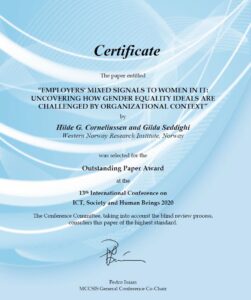New publication: Corneliussen, H. G., & Seddighi, G. (2020). Employers’ Mixed Signals to Women in IT: Uncovering how Gender Equality Ideals are Challenged by Organizational Context. In P. Kommers & G. C. Peng (Eds.), Proceedings for the International Conference ICT, Society, and Human Beings 2020 (41-48): ADIS Press.
Why is it so difficult to achieve gender balance in IT work? Our study of attitudes towards women’s under-representation in IT and how IT employers and organizations deal with this imbalance, give some of the answers. These are some of the attitudes that work as barriers to recruit more women to IT work:
- When many women hold other (non-IT) positions in an organization, recruiting women to IT work does not necessarily appear as important because the organization at large does not experience a gender imbalance.
- Recruiting women is often seen as a question of work environment rather than who holds IT positions.
- Gender equality is interpreted as “treating everybody the same”, and since women are welcome (even when they don’t apply to IT jobs), their under-representation is not considered a gender equality challenge.
- Focus on gender equality in IT has to yield for other types of marginalization in the organization, for instance for immigrants or people with disabilities.
- Stereotypical ideas about who the best and most interested IT workers are, are still strong in Norway, making employers doubt that it will be possible to recruit women; or, even questioning whether women do have the “right” competence.
- Gender imbalance in IT is seen as a temporary challenge that will eventually fix itself.
While the many alternative approaches takes the energy out of gender equality work, the national gender equality regime – gender equality as something good and something we all want – is not questioned.
Based on this analysis we have proposed a model that contributes to explaining the Nordic Gender Equality Paradox, illustrating how the gender equality norm can co-exist with the very attitudes that undermine the norm.
Our paper also received the Outstanding Paper Award at the ICT, Society, and Human Beings 2020 Conference!

